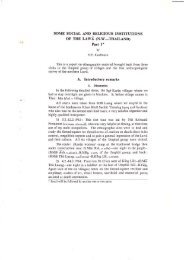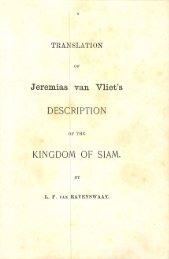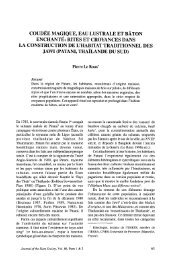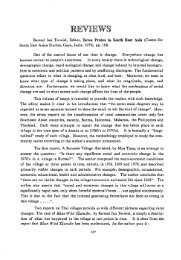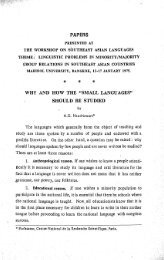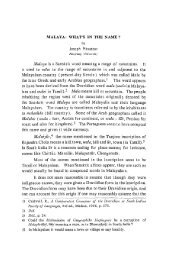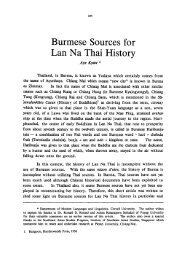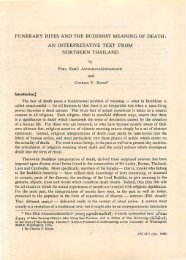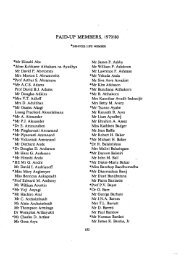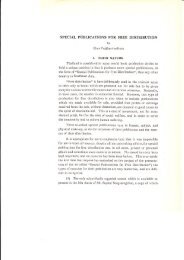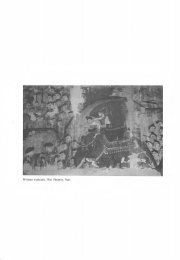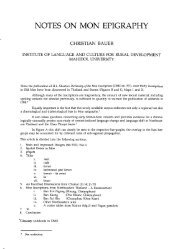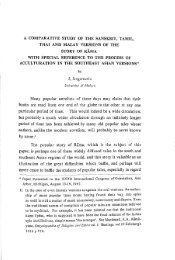Burma Research Society, Fiftieth Anniversary Publication No. 1 ...
Burma Research Society, Fiftieth Anniversary Publication No. 1 ...
Burma Research Society, Fiftieth Anniversary Publication No. 1 ...
Create successful ePaper yourself
Turn your PDF publications into a flip-book with our unique Google optimized e-Paper software.
BOOK REV! EWS<br />
<strong>Burma</strong> <strong>Research</strong> <strong>Society</strong>, <strong>Fiftieth</strong> <strong>Anniversary</strong> <strong>Publication</strong> <strong>No</strong>. 1,<br />
Rangoon 1961. 543 pages.<br />
To commemorate its golden anniversary, the <strong>Burma</strong> <strong>Research</strong><br />
<strong>Society</strong> held a special conference in 1960 and in vi ted a wide variety<br />
of scholars to participate and to contribute papers. Twenty-one of<br />
the essays were publisbecl a year later and they make up the content<br />
of the present volume. The subject matter of the papers ranges<br />
widely from mythology to economics, from pulp-making to geology,<br />
and from linguistics to history. IVIost re Ia to to some aspect of Burmese<br />
life and its environment. A very few draw their subject matter<br />
from Thai and Vietnamese culture. Clearly, with so many different<br />
topics, it is impossible for any one reviewer to do justice to the<br />
entire collection. Therefore, it is the intention of this writer to<br />
concentrate upon a few crf the papers in the areas of his specialization<br />
and attempt to make valid and constntctive comments.<br />
Looking broadly at the essays in the areas of history and<br />
social science, one is struck by their rather ordinary quality a11d<br />
their lack of any new and original interpretations of their topics.<br />
Most are limited to a narrowly conceived subject which, although<br />
well researched, is presented in an unimaginative and style. less way.<br />
Yet, individually, they cannot be dismissed, for each in its own way<br />
adds something which may be useful to students of Burmese life<br />
and culture.<br />
Three essays fall into the category of history. Each seeks to<br />
open a new area in the study of <strong>Burma</strong>. The most significant of<br />
them is the article written by Dr. Thaung, a former member of the<br />
Rangoon University faculty. Her paper, entitled, Panthay Interlude<br />
in Yunnan :a Study in Vicissitudes Through The Burmese Kaleidoscope,<br />
is drawn largely from her London University doctoral thesis. It<br />
presents an interestir.g and useful description of the often-mentioned,<br />
but little known Chinese Muslim uprising in the nineteenth<br />
century. As her title indicates, she views the actors and events<br />
from the perspective of the Burmese and the British in <strong>Burma</strong> who<br />
desired to trade with the people in the troubled area and who hoped<br />
to benefit economically from the ill-fated revolt. The essay's chief<br />
value lies in the new material which the author uncovered.<br />
If Daw Thaung represents the post-World War Two genera-<br />
1;1on of indi(Senous historians, the pre-war generation of foreit5n
i300K REVIEWS 55<br />
In 1925 sections dealing with the political and religious history<br />
were translated and published by Dr. Coedes in his Documents<br />
sur l' Histoire politique et religiease du Laos occidental (BEFEO XXV)<br />
which was later utilised for another article in English by Dr. S.<br />
Paranavitana entitled Religious Intercourse between Ceylon and Sictm<br />
in the 13th-15th centuries ( JRAS Ceylon Branch 1932 ). In 1958 the<br />
Fine Arts Department of the Royal Thai Government asked Dr. Sen<br />
Manavidiin to translate it again into Siamese which was duly reviewed<br />
in English in JSS XL VI, 2, 1958, pp. 232-236. The review<br />
gave a full analysis because the original translation was only accessible<br />
to scholars who read Siamese. This translation was made from<br />
the edition of 1908; but, finding important passages which were<br />
doubtful, the translator searched the National Library for whatever<br />
manuscripts there must have been of the edition of 1794 which<br />
formed the basis of the edition of 1908. His effort was duly rewarded<br />
but again as this source was incomplete further search was made<br />
resulting in the discovery of an other set of palmleafs in the Library<br />
of the Chapel Royal of the Emerald Buddha. These were practically<br />
identical with the first batch of manuscripts. With these<br />
sources Dr. Manavidun managed to collate and produce a new version<br />
of the Siamese translation which was published with notes and<br />
accessories.. One cannot but feel it a pity that the sources were<br />
not available to the learned editor of the volume of the Pali Text<br />
<strong>Society</strong>.<br />
In this review of the latter references are freely made to the<br />
new Siamese translation of 1958.<br />
I have made use too of the enumeration of variations in read<br />
ing kindly supplied me by the Director-General of the Fine Arts<br />
Department who has also had a list made of the proper names of<br />
persons and places many of which have been incongruously given<br />
Pali forms in a manner not dissimilar from the coinages into a sort<br />
of Latin in mediaeval Europe which go by the name of 'doc Latin'.<br />
In the hope therefore of facilitating future research, those variations<br />
are hereunder given. The Ayudhya version of 1794 will be referred
62<br />
BOOK REVIEWS<br />
Like its contemporary, the Tebhumikatha of King Li.tai, often<br />
known by its modern name of Traibhumi Pra Rua'!J, the ]inalcalamiili<br />
made a point of recording names of monastic scholars in the Budohist<br />
lands it described. It also gave its list of source material, a<br />
babit hardly ever indulged in in later works till the influx of western<br />
methods of research.<br />
While the Text of the Pal-i Text <strong>Society</strong> is, as far as the limitation<br />
of :its somce material permitted, an evidence of experienced<br />
scholarship; the New Siamese Translation thongh in obviously less<br />
experienced hands is indicative of the new spirit of literary criticism<br />
which is being so assiduously promoted by the personal<br />
guidance of the learned Director- General of the Fine Arts<br />
Department.<br />
It is of interest to the Siamese reader especially that the Text<br />
under review has been published ttnder the royal 11atronage of His<br />
Majesty onr King to commemorate his visit to Great Britain on the<br />
19th-20th July 1960. The r esture is reminiscent of the patronage<br />
of His Majest',l's grandfather, King Chulalongkorn, of the first two<br />
volumes of the series Sacred Books of the Buddhists undertaken<br />
in similar quarters in England.<br />
Bangkok, 2Sth june 1962.<br />
Minney, R.J,: Fanny and the Regent of Siam, Collins, London 1962,<br />
ill. 382 pages<br />
The book is admittedly a sequel of Anna and the King of Siam<br />
which Mrs London based on an older book on the same topic by<br />
Mrs. Anna Leonowens. Instead, however, of King Mongkut, the<br />
Regent Somdec Caopraya Boromamaha Srisuriyawol)S, comes in for<br />
his share of being the villain, a r6le which Mrs Leonowens took<br />
care to keep him out of though it is obvious from the book that she<br />
had no more liking for him either. The King was however already<br />
dead at the time when Mrs Leonowens wrote, just as the Regent<br />
now is when Minney writes the book under review; and none of his<br />
great power to avenge a wrong exists any longer. British chivalry,<br />
it is true, would frown on such a timing but then not everybody is<br />
bound to observe this chivalry.<br />
D.
BOOK REVIEWS 63<br />
As a novel the book is very well written. The characterisation<br />
is well handled for a fiction though lacking in its understanding<br />
of Siamese nature. Needless to say, Fanny is the heroine and<br />
therefore demands the greater part of attention; but the cleverest<br />
characterisation would perhaps be that of Sir Thomas Knox, painted<br />
as a man of ideals of the XIX century type which was responsible<br />
for the maintenance of the British Raj, a Victorian who never<br />
doubted tbat heaven willed the superiority of his nation over orientals<br />
and in fact over the whole world. Fanny was made to develop<br />
her wayward vivacity of a young woman into a determined vindictiveness,<br />
almost unnatural, after the tragedy of her husband's unjust<br />
persecution.<br />
Unfortunately the author seemed to claim a certain amount<br />
of historical standing for his novel for he says in his foreword "It<br />
would be as true to say of this book as Margaret Landon said of Anna<br />
mul the King of Siam that 75 percent of it is based on fact". Of this<br />
claim it were best to discuss as little as possible. Just to support<br />
my verdict let me cite a few instances of anachronisms. Prince<br />
Damrong was 13 at the time of Fanny's arrival back in Bangkok<br />
( p. 21) but within a short time he appeared as one of her suitors<br />
inspite of the heroine's seniority in age by no less than 4 years<br />
(p. 63). The Knox family seemed to have already been in the habit<br />
of holidaying at H uahin (p. 93) but Huahin did not become a seaside<br />
resort till some 50 years later.<br />
As Mrs Leonowens claimed to have been responsible-almost<br />
solely--for King Chulalongkorn's initiaiive in reform and progress,<br />
our novel too claims that Fanny was responsible for the 'good work'<br />
(p. 381) of 'Prosit' who 'helped to achieve the coup d'etat of 1932'.<br />
The person referred to by this fictitious name is obvious and he was<br />
not yet a man at that time. As for the author's suggestion of an<br />
inscription to the credit of Fanny being engraved on the monument<br />
of democracy one canot but give a sigh of relief for the good name<br />
of the heroine of our novel.<br />
The illustrations arc judiciously selected.<br />
Bangkok, 23 June 1962<br />
D.
RECENT SIAMESE PUDLICATJONS 67<br />
from India and the accompanying development of Buddhist art.<br />
Section VIII gives us the history of Buddhism in Siam, of which<br />
four phases are enumerated, namely: the original Theravacla<br />
Buddhism of Dvaravati, the Mahayanist school derived from the<br />
I<br />
Empires of Srivijaya and Kambuja, the Theravada school from the<br />
Burmese Empire of Pagan under the leadership of Aniruddha and<br />
the Theravacla School of Ceylon introduced into the valley of the<br />
Caopraya in the Xllth century which has remained to the present<br />
rlay thongh greatly modified by the Man-inspired reformation of<br />
King Mongkut in the XIX th century now going by the name of the<br />
Dhammayutika School.<br />
The legitimate material of the work describing Buddhist art<br />
in Sinm forms section XIX (pp. 92-149), which is about just less<br />
than half of the volume. It traces the history of the monuments in<br />
Dvarnvati (circa Ist century of the Christian era) centering around<br />
Nakon Pathom and stretching thenee towards the provinces of<br />
Rajaburi, Pejraburi, Su1'!an and Lo]J{mri. Its centre at Nako11 Pathom<br />
contains a great number of artistic sites and remains. The<br />
Mahayanist phase is to be found mostly on the southern peninsula<br />
then the LoiJburi, ChieiJSCn with its descendant of Chiel)mai. Then<br />
comes the art of Sukhodaya, in w hieh the inspiration of Ceylon's<br />
tradition of the Buddhist superman blossomed forth into the ideal<br />
of the national plastic art which gave rise to such marvelous<br />
mouldings as the Lord of Vietory of l)isnulok and the Victorious<br />
Lion now enshrined in the main chapel of wat Boworaniwes, ending<br />
up with the less distinguished art of Ayudhya and modern times.<br />
As a pioneer work on Buddhist art in Siamese the work has<br />
remained an unehallenged clasHie since its inception. It has nevertheless<br />
given rise to debatable points, two of which would be worth<br />
mention as follows :<br />
On pp. 61 & 98 etsqq the distinguished historian accepts the<br />
theory that the Buddha-effigy of the type known as the " Regal<br />
Buddha", i.e. the Master wearing a crown and regal robes originated<br />
from Mahayanist ideals. The theory may be true ; but there is a
l:lECE!IlT SIAMESE PUIJLICA1'iONS 69<br />
I .<br />
Pra Yaowaraj, i.e. a Prince who was son to the King and the other<br />
three of Khun with the names of Prohm-montri, Sri Krawiraj and<br />
Saraprasroeth. Its date had been originally fixed by scholars of the<br />
Bangkok period to the XVIIth century when King Narai had around<br />
him a circle of famous poets, none of whom however has been so far<br />
identified with actually known poets of that golden age of poetry.<br />
The author of the book under review has now come forward with a<br />
startling rejection of this former date and, in a long dissertation in<br />
the introduction, attributes the poem to one of the sons of King<br />
Boromatrailokanath (1448-1488), thus shifting its chronology back<br />
some two hundred years. Had he thus decided on the ground of<br />
language there would have been every reason for following him because<br />
the language resembles many works of that era; but in identifying<br />
its author with a son of King Boromatrailokanath his<br />
arguments are not altogether strong and leave his decision open to<br />
doubt. The reviewer is personally inclined to fall in with the<br />
author as to the age of the poem from the nature of its language but<br />
is not convinced about his identification of the Y aowaraj with the<br />
third son of that King.<br />
The method of interpretation is praiseworthy. Taking a<br />
stanza one by one, he gives its text, with collations of eight other<br />
versions, then a paraphrase in modern Siamese and a discussion of<br />
the vocabulary employed which is for the most part obsolete. Unfortunately<br />
he bas only done this to the first hundred of the 260<br />
stanzas.<br />
The literary merit of this Ayudhya version of the Twelve Months<br />
has long been upheld by scholastic circles. Its references to figures<br />
of Thai romance place the poem at a date near the composition, also<br />
in the north, of the lt'ifty ]ataka (Pafifiasa-]ataka), a source of inspiration<br />
for mediaeval writers o£ dance-dramas, which have been<br />
fixed at a period ranging from the XVth to the XVIIth centuries.<br />
As for its plot there is but little. After due salutations to<br />
the Hindu Trinity and the sovereign of the land (stanzas 1-5 ), we<br />
come to some 24 stanzas which are mainly erotie with no other



